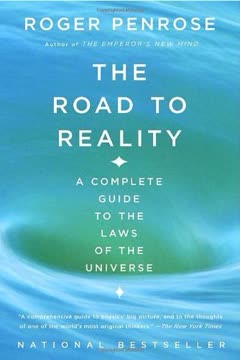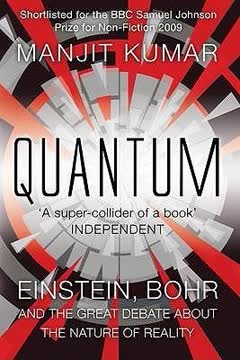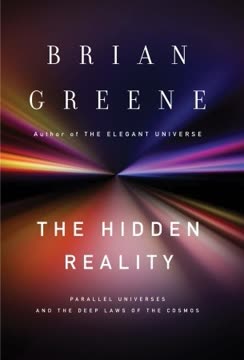Key Takeaways
1. Geometry's Truth Lies in Physical Correspondence
The concept “true” does not tally with the assertions of pure geometry, because by the word “true” we are eventually in the habit of designating always the correspondence with a “real” object.
Geometry and Reality. Euclidean geometry, with its axioms and theorems, is not inherently "true" in an absolute sense. Its validity stems from its correspondence to real-world objects and measurements. Geometry becomes a branch of physics when its propositions are tested against the behavior of rigid bodies and the measurement of distances.
Ruler and Compass. The "truth" of a geometrical proposition is understood as its validity for constructions with a ruler and compass. This conviction is based on incomplete experience, and the general theory of relativity later reveals the limitations of this "truth."
Example: The straight line, a fundamental concept in geometry, is associated with a natural object. Three points on a rigid body lie on a straight line when the middle point minimizes the sum of the distances to the other two. This physical interpretation grounds geometry in the observable world.
2. Reference Frames Dictate Motion's Description
There is no such thing as an independently existing trajectory (lit. “path-curve”1), but only a trajectory relative to a particular body of reference.
Relative Motion. The description of motion is always relative to a chosen reference frame. There is no absolute motion or trajectory independent of an observer's perspective. The path of an object, whether a straight line or a curve, depends on the reference frame from which it is observed.
Example: A stone dropped from a moving train appears to fall in a straight line to a passenger, but to a stationary observer on the ground, it follows a parabolic path. Both descriptions are valid, each relative to its respective reference frame.
Coordinate Systems. The concept of a "body of reference" can be formalized using coordinate systems. The position of an event is specified by its coordinates relative to a rigid body. The Cartesian system, with its three perpendicular axes, provides a numerical way to describe positions in space.
3. Classical Mechanics Relies on Inertial Frames
A system of co-ordinates of which the state of motion is such that the law of inertia holds relative to it is called a “Galileian system of co-ordinates.”
Law of Inertia. Classical mechanics, as formulated by Galilei and Newton, is based on the law of inertia: a body remains at rest or in uniform motion unless acted upon by a force. This law holds only in specific reference frames called Galileian or inertial frames.
Fixed Stars. The fixed stars serve as an approximate inertial frame. A coordinate system attached to the Earth is not inertial because the stars appear to move in circles relative to it, violating the law of inertia.
Galileian Frames. The laws of mechanics are valid only for Galileian coordinate systems. These systems are in uniform motion relative to each other. This restriction highlights a limitation of classical mechanics.
4. Relativity Extends Equivalence to All Frames
If, relative to K, K′ is a uniformly moving co-ordinate system devoid of rotation, then natural phenomena run their course with respect to K 'according to exactly the same general laws as with respect to K.
Principle of Relativity. The principle of relativity states that the laws of nature are the same for all observers in uniform motion. This means that no experiment can distinguish between a state of rest and a state of uniform motion.
Anisotropy Absence. The absence of anisotropic properties in terrestrial physical space supports the principle of relativity. Experiments have failed to detect any physical non-equivalence of different directions, which would be expected if the Earth were moving through a privileged reference frame.
Generalization. The general principle of relativity extends this equivalence to all bodies of reference, regardless of their state of motion. This generalization requires a new understanding of space and time.
5. Time's Relativity Defies Absolute Simultaneity
Events which are simultaneous with reference to the embankment are not simultaneous with respect to the train, and vice versa (relativity of simultaneity).
Simultaneity is Relative. The concept of simultaneity is not absolute but depends on the observer's reference frame. Two events that are simultaneous in one frame may not be simultaneous in another frame moving relative to the first.
Lightning Strikes. Imagine lightning striking two points, A and B, on a railway embankment. An observer at the midpoint between A and B on the embankment sees the flashes simultaneously. However, an observer on a train moving relative to the embankment will see one flash before the other.
Reference Frame Dependence. Every reference frame has its own particular time. A statement of time is meaningless without specifying the reference frame to which it refers. This challenges the classical assumption of absolute time.
6. Lorentz Transformation Bridges Reference Frames
This system of equations is known as the “Lorentz transformation.”
Incompatibility Resolution. The apparent conflict between the constancy of the speed of light and the principle of relativity is resolved by the Lorentz transformation. This set of equations relates space and time coordinates between different reference frames.
Transformation Equations. The Lorentz transformation equations are:
- x′ = (x - vt) / √(1 - v²/c²)
- y′ = y
- z′ = z
- t′ = (t - vx/c²) / √(1 - v²/c²)
Velocity of Light. The Lorentz transformation ensures that the speed of light is the same in all reference frames. If a light signal travels along the x-axis with velocity c in frame K, it will also travel with velocity c in frame K'.
7. Mass and Energy Are Fundamentally Equivalent
The inertial mass of a system of bodies can even be regarded as a measure of its energy.
Unified Conservation Law. The special theory of relativity unites the conservation of energy and the conservation of mass into a single law. Mass is not constant but varies with the energy of the body.
Mass Increase. If a body absorbs energy E, its inertial mass increases by an amount E/c². This relationship is expressed by the famous equation E = mc².
Energy Expression. The energy of a body is given by mc²/√(1 - v²/c²), where mc² represents the energy possessed by the body before it absorbs any additional energy. This term is significant even when the body is at rest.
8. General Relativity Explains Gravitation as Curvature
The earth produces in its surroundings a gravitational field, which acts on the stone and produces its motion of fall.
Gravitational Field. General relativity describes gravity not as a force but as a curvature of space-time caused by mass and energy. Objects move along geodesics, which are the shortest paths in this curved space-time.
Equivalence Principle. The equivalence principle states that the effects of gravity are indistinguishable from the effects of acceleration. This is illustrated by the thought experiment of an observer in an accelerating chest, who experiences the same effects as if they were in a gravitational field.
Inertial and Gravitational Mass. The equality of inertial and gravitational mass is a consequence of the equivalence principle. This law implies that the same property of a body manifests itself as inertia or as weight, depending on the circumstances.
9. Gravity's Influence on Light Reveals Space-Time
From this we conclude, that, in general, rays of light are propagated curvilinearly in gravitational fields.
Curvature of Light. General relativity predicts that light rays are bent by gravitational fields. This effect is most noticeable when light passes close to massive objects like the sun.
Experimental Verification. The bending of light was confirmed during a solar eclipse in 1919. Stars near the sun appeared to be displaced from their usual positions, as predicted by the theory.
Variable Velocity of Light. The curvature of light rays implies that the velocity of light varies with position in a gravitational field. This challenges the constancy of the speed of light assumed in the special theory of relativity.
10. The Universe's Structure is Tied to Matter's Density
According to the general theory of relativity, the geometrical properties of space are not independent, but they are determined by matter.
Matter and Geometry. The general theory of relativity links the geometry of space to the distribution of matter. The presence of matter curves space-time, influencing the motion of objects and the propagation of light.
Non-Euclidean Universe. The influence of matter on space-time excludes the possibility of exact Euclidean geometry in the universe. The universe may be quasi-Euclidean, but calculations suggest that the average density of matter would necessarily be zero in such a case.
Spherical Universe. If the universe has a non-zero average density of matter, it must be spherical or elliptical. The theory provides a connection between the space-expanse of the universe and the average density of matter within it.
11. Space-Time is a Construct Shaped by Experience
Physical objects are not in space, but these objects are spatially extended. In this way the concept “empty space” loses its meaning.
Space-Time as a Construct. Space and time are not independent entities but constructs shaped by our experiences and observations. The concept of "empty space" loses its meaning, as physical objects are spatially extended.
Objective Reality. The objective world is composed of events localized in space and time. Physical descriptions involve statements about the space-time coincidence of two events.
Gaussian Coordinates. The description of the time-space continuum using Gaussian coordinates replaces the description with a body of reference. This approach is not tied down to the Euclidean character of the continuum.
Last updated:
FAQ
What is "Relativity: The Special and the General Theory" by Albert Einstein about?
- Accessible explanation of relativity: The book provides a non-mathematical introduction to both the Special and General Theories of Relativity, aiming to make Einstein’s revolutionary ideas understandable to readers without advanced physics backgrounds.
- Structure and content: It is divided into three main parts: the Special Theory of Relativity, the General Theory of Relativity, and considerations on the universe as a whole, plus several appendices for deeper exploration.
- Focus on conceptual clarity: Einstein emphasizes the physical meaning behind the theories, using thought experiments and analogies to clarify complex concepts.
- Historical and philosophical context: The book also discusses the evolution of ideas about space, time, and gravity, and how relativity challenges classical physics.
Why should I read "Relativity: The Special and the General Theory" by Albert Einstein?
- Direct insight from Einstein: The book is written by Einstein himself, offering a unique opportunity to learn the theory from its creator.
- Foundational scientific ideas: Understanding relativity is essential for grasping modern physics, cosmology, and the nature of the universe.
- Accessible to non-specialists: Einstein intentionally avoids heavy mathematics, making the book suitable for readers with a general scientific background.
- Philosophical implications: The book explores deep questions about reality, space, time, and the limits of human knowledge.
What are the key takeaways from "Relativity: The Special and the General Theory"?
- Relativity of space and time: Space and time are not absolute but depend on the observer’s state of motion, fundamentally altering our understanding of the universe.
- Constancy of the speed of light: The speed of light in a vacuum is the same for all observers, regardless of their motion, leading to surprising consequences like time dilation and length contraction.
- Equivalence of mass and energy: The famous equation E=mc² emerges from the theory, uniting mass and energy as interchangeable.
- Gravity as geometry: In General Relativity, gravity is not a force but a manifestation of the curvature of space-time caused by mass and energy.
- Experimental confirmation: The book discusses key experiments (e.g., Mercury’s perihelion, light deflection by the sun) that support the theory.
How does Einstein define the Special Theory of Relativity in "Relativity: The Special and the General Theory"?
- Principle of relativity: The laws of physics are the same in all inertial (non-accelerating) reference frames; no frame is preferred.
- Constancy of light speed: The speed of light in a vacuum is constant for all observers, regardless of their motion or the motion of the light source.
- Consequences for measurements: Time intervals and lengths are not absolute but depend on the observer’s relative motion (time dilation and length contraction).
- Lorentz transformation: The mathematical framework (Lorentz transformation) replaces the classical Galilean transformation to relate measurements between moving frames.
What is the General Theory of Relativity according to Einstein’s book?
- Extension to acceleration and gravity: General Relativity extends the principle of relativity to all reference frames, including those that are accelerating.
- Equivalence principle: There is no observable difference between acceleration and gravitational fields; inertial and gravitational mass are equivalent.
- Gravity as space-time curvature: Massive objects cause space-time to curve, and this curvature dictates the motion of objects and light.
- New predictions: The theory predicts phenomena such as the bending of light by gravity and the precession of planetary orbits.
How does "Relativity: The Special and the General Theory" explain the relativity of simultaneity?
- Simultaneity is observer-dependent: Events that are simultaneous in one reference frame may not be simultaneous in another moving frame.
- Thought experiment with trains: Einstein uses the example of lightning strikes observed from a train and an embankment to illustrate how simultaneity depends on the observer’s motion.
- Role of light signals: The definition of simultaneity relies on the assumption that light travels at the same speed in all directions for all observers.
- Implications for time: This leads to the conclusion that time is not absolute but relative to the observer’s frame of reference.
What is the Lorentz transformation, and why is it important in Einstein’s "Relativity: The Special and the General Theory"?
- Mathematical tool for relativity: The Lorentz transformation provides the equations that relate space and time coordinates between two inertial frames moving at constant velocity relative to each other.
- Preserves the speed of light: Unlike the Galilean transformation, the Lorentz transformation ensures that the speed of light remains constant for all observers.
- Foundation for relativistic effects: It explains phenomena such as time dilation, length contraction, and the relativity of simultaneity.
- Essential for both theories: The Lorentz transformation is central to both Special and General Relativity, underpinning their mathematical structure.
How does Einstein’s "Relativity: The Special and the General Theory" describe the relationship between mass and energy?
- E=mc² explained: The book derives and explains the famous equation, showing that mass and energy are two forms of the same thing.
- Mass increases with energy: When a body absorbs energy, its inertial mass increases accordingly.
- Unified conservation law: The conservation of mass and the conservation of energy are unified into a single law in relativity.
- Experimental confirmation: The equivalence of mass and energy is confirmed by nuclear reactions and radioactive decay, as discussed in the book.
What experimental evidence does Einstein present in "Relativity: The Special and the General Theory" to support his theories?
- Mercury’s perihelion advance: The unexplained rotation of Mercury’s orbit is accurately predicted by General Relativity.
- Deflection of starlight: Light from stars passing near the sun is bent by the sun’s gravity, confirmed during solar eclipses.
- Gravitational redshift: Light emitted from massive bodies is shifted to longer wavelengths, as predicted by the theory.
- Fizeau’s experiment: The speed of light in moving water supports the relativistic addition of velocities rather than the classical one.
How does "Relativity: The Special and the General Theory" address the structure and geometry of the universe?
- Space is not absolute: The geometry of space is determined by the distribution of matter and energy, not fixed independently.
- Finite but unbounded universe: Einstein discusses the possibility of a universe that is finite in volume but has no boundaries, using analogies like the surface of a sphere.
- Role of non-Euclidean geometry: The book explains how space can be curved, requiring non-Euclidean geometry to describe it.
- Cosmological implications: The general theory leads to new models of the universe, including expanding and closed universes.
What are the best quotes from "Relativity: The Special and the General Theory" by Albert Einstein, and what do they mean?
- “The present book is intended, as far as possible, to give an exact insight into the theory of Relativity to those readers who...are not conversant with the mathematical apparatus of theoretical physics.”
Einstein’s goal is to make his revolutionary ideas accessible to a broad audience, not just specialists. - “Physical objects are not in space, but these objects are spatially extended. In this way the concept ‘empty space’ loses its meaning.”
Einstein challenges the classical notion of space as a container, emphasizing the inseparability of objects and space. - “Events which are simultaneous with reference to the embankment are not simultaneous with respect to the train, and vice versa (relativity of simultaneity).”
A clear statement of how relativity overturns the idea of absolute time. - “The gravitational mass of a body is equal to its inertial mass.”
This equivalence is a cornerstone of General Relativity, leading to the insight that gravity and acceleration are fundamentally linked.
How does Einstein’s "Relativity: The Special and the General Theory" approach the philosophical implications of space and time?
- Space and time as constructs: Einstein argues that space and time are not absolute entities but are defined by the relationships between physical events.
- No absolute reference frame: The book rejects the idea of a privileged or absolute frame of reference, emphasizing the relativity of all motion.
- Field replaces substance: The concept of the field (especially the gravitational field) replaces the notion of space as a passive stage for events.
- Limits of human knowledge: Einstein acknowledges the provisional nature of scientific theories and the importance of intuition and creativity in scientific progress.
Review Summary
Relativity receives mostly positive reviews, with readers praising Einstein's attempt to explain complex theories to the general public. Many find it challenging but rewarding, appreciating Einstein's clear writing and use of examples. Some criticize it as too difficult for laypeople, suggesting other books for beginners. Readers note the book's historical significance and Einstein's philosophical approach. Several mention the need for basic mathematical knowledge to fully grasp the content. Overall, it's seen as an important work that provides insight into Einstein's groundbreaking ideas.
Similar Books








Download PDF
Download EPUB
.epub digital book format is ideal for reading ebooks on phones, tablets, and e-readers.




